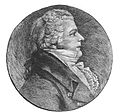| Representative | Party | Term | Cong
ress | Electoral history |
|---|
| District established March 4, 1803 |
John Clopton
(Tunstall) | Democratic-Republican | March 4, 1803 –
March 3, 1813 | 8th
9th
10th
11th
12th | Redistricted from the 10th district and re-elected in 1803.
Re-elected in 1805.
Re-elected in 1807.
Re-elected in 1809.
Re-elected in 1811.
Redistricted to the 23rd district . |

Hugh Nelson
(Milton) | Democratic-Republican | March 4, 1813 –
January 14, 1823 | 13th
14th
15th
16th
17th | Elected in 1813.
Re-elected in 1815.
Re-elected in 1817.
Re-elected in 1819.
Re-elected in 1821.
Resigned to become U.S. Minister to Spain. |
| Vacant | January 15, 1823 –
March 3, 1823 | 18th | |

Alexander Smyth
(Wythe County) | Crawford
Democratic-Republican | March 4, 1823 –
March 3, 1825 | Redistricted from the 6th district and re-elected in 1823.
Lost re-election. |
Benjamin Estil
(Abingdon) | Anti-Jacksonian | March 4, 1825 –
March 3, 1827 | 19th | Elected in 1825.
Lost re-election. |

Alexander Smyth
(Wythe County) | Jacksonian | March 4, 1827 –
April 17, 1830 | 20th
21st | Elected in 1827.
Re-elected in 1829.
Died. |
| Vacant | April 17, 1830 –
December 5, 1830 | 21st | |
Joseph Draper
(Wythe County) | Jacksonian | December 6, 1830 –
March 3, 1831 | Elected to finish Smyth's term.
Lost re-election. |
Charles C. Johnston
(Abingdon) | Jacksonian | March 4, 1831 –
June 17, 1832 | 22nd | Elected in 1831.
Died. |
| Vacant | June 18, 1832 –
December 5, 1832 | |
Joseph Draper
(Wythe County) | Jacksonian | December 6, 1832 –
March 3, 1833 | Elected to finish Johnston's term.
Retired. |
| District dissolved March 4, 1833 |